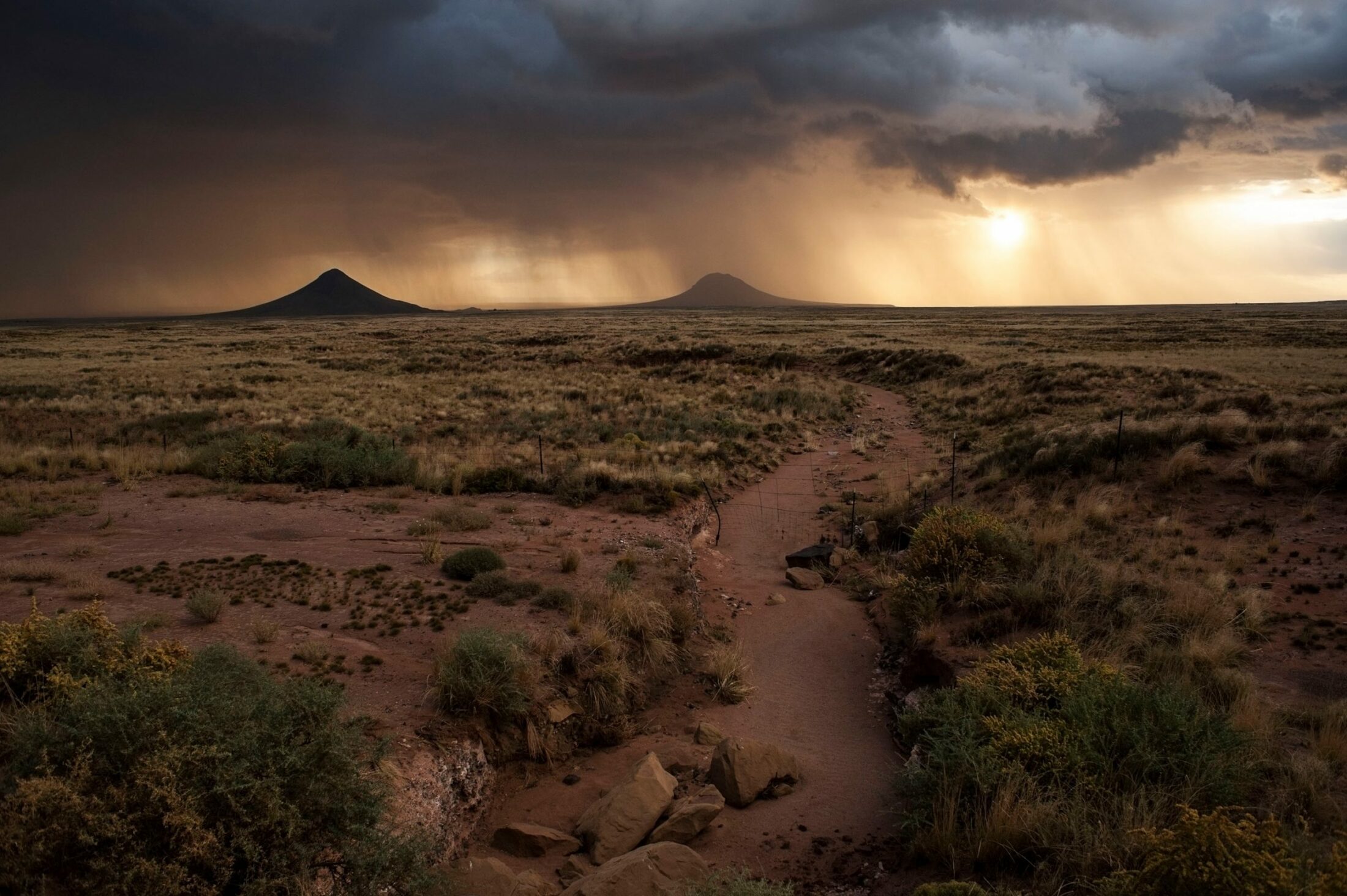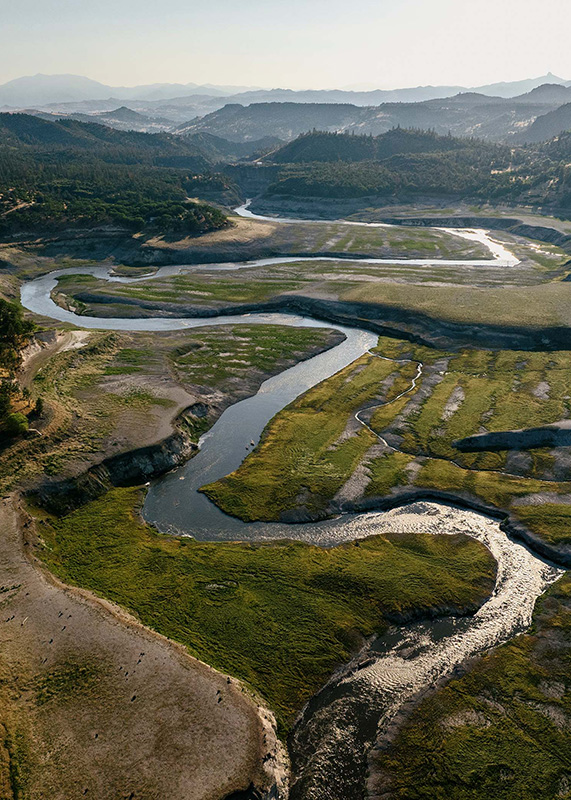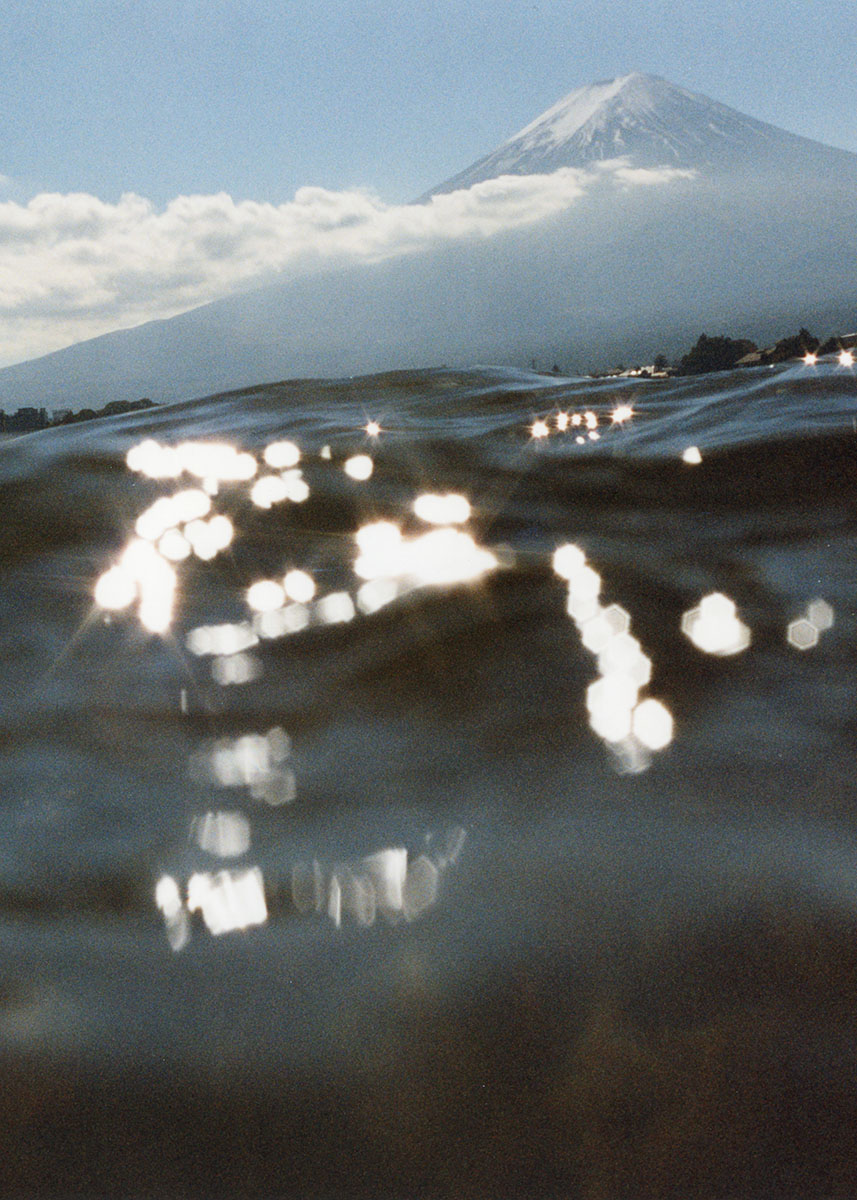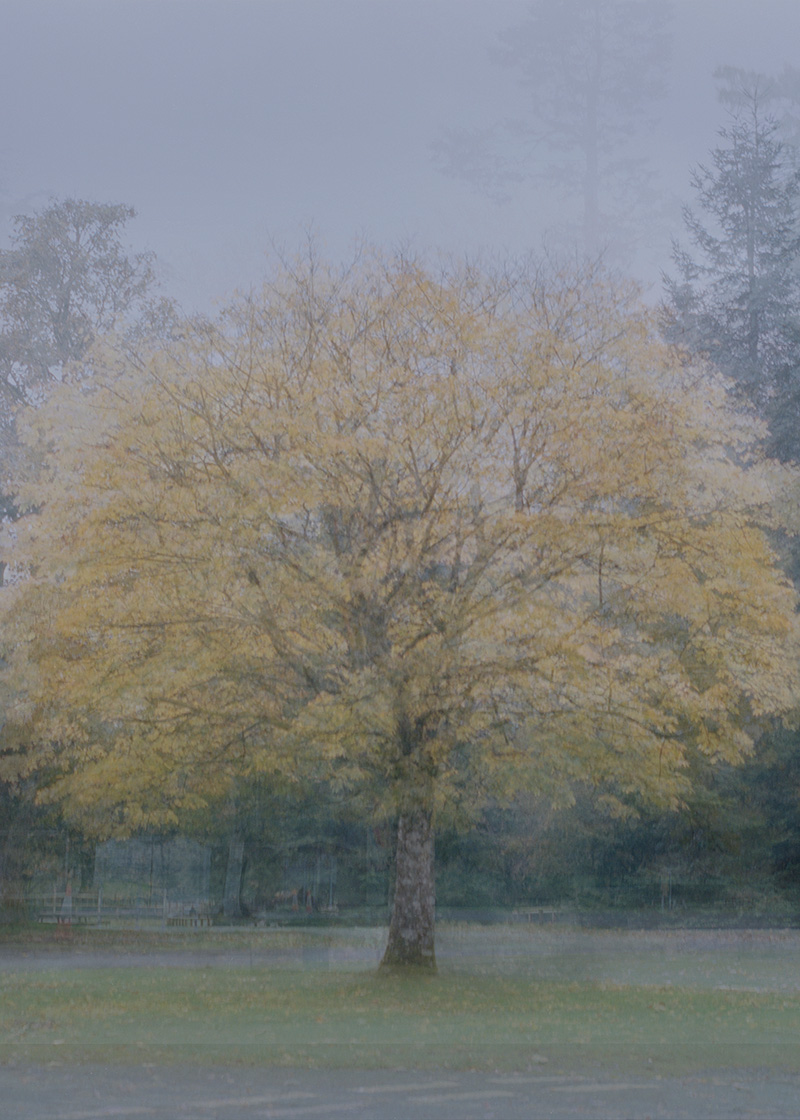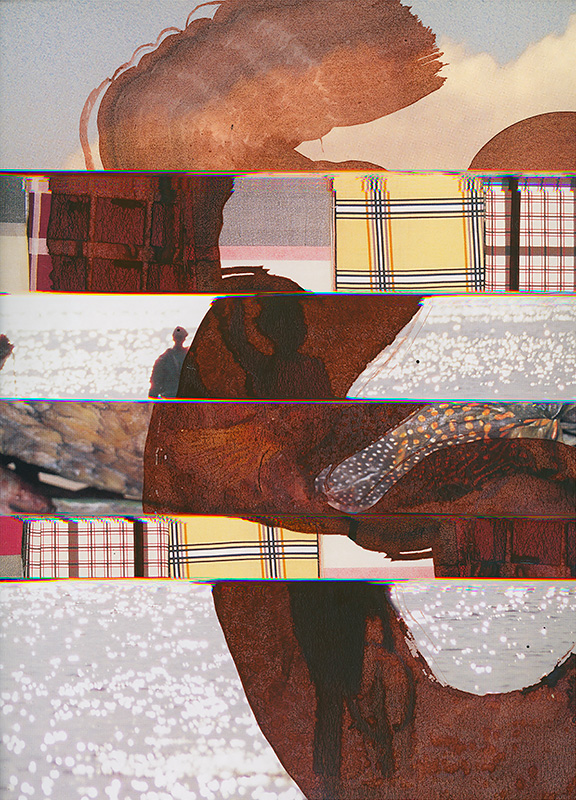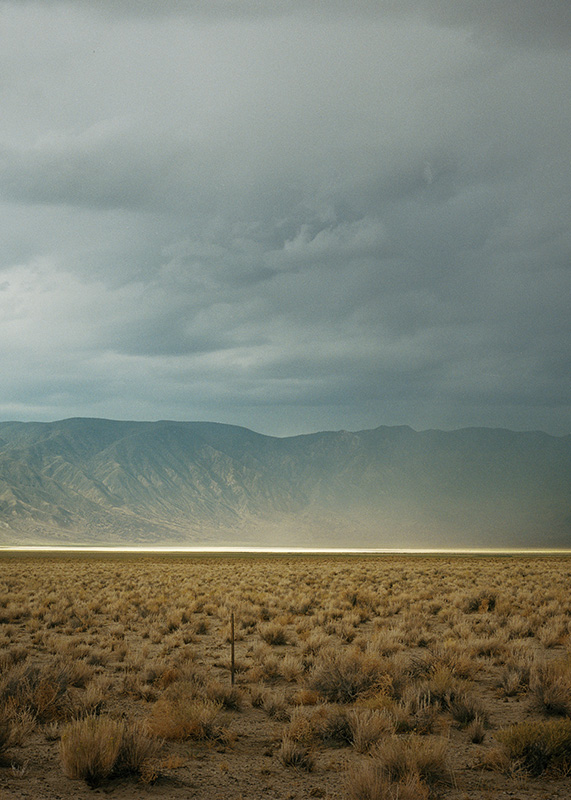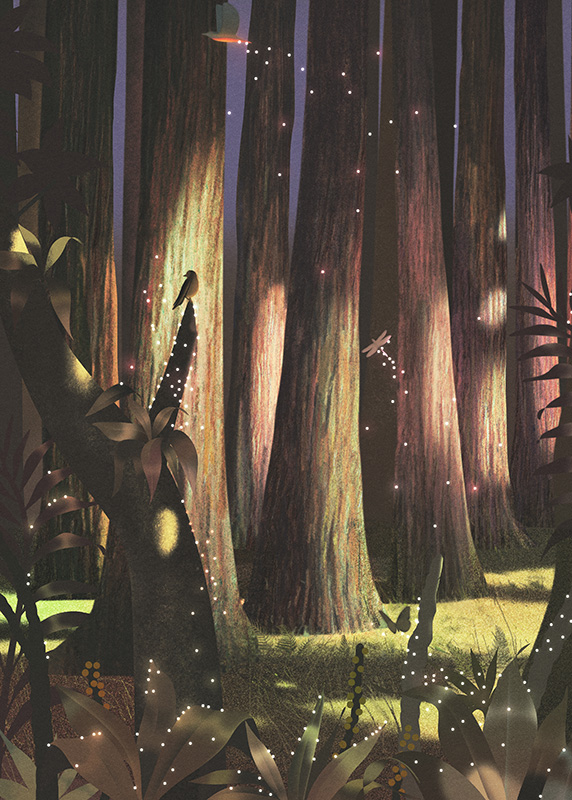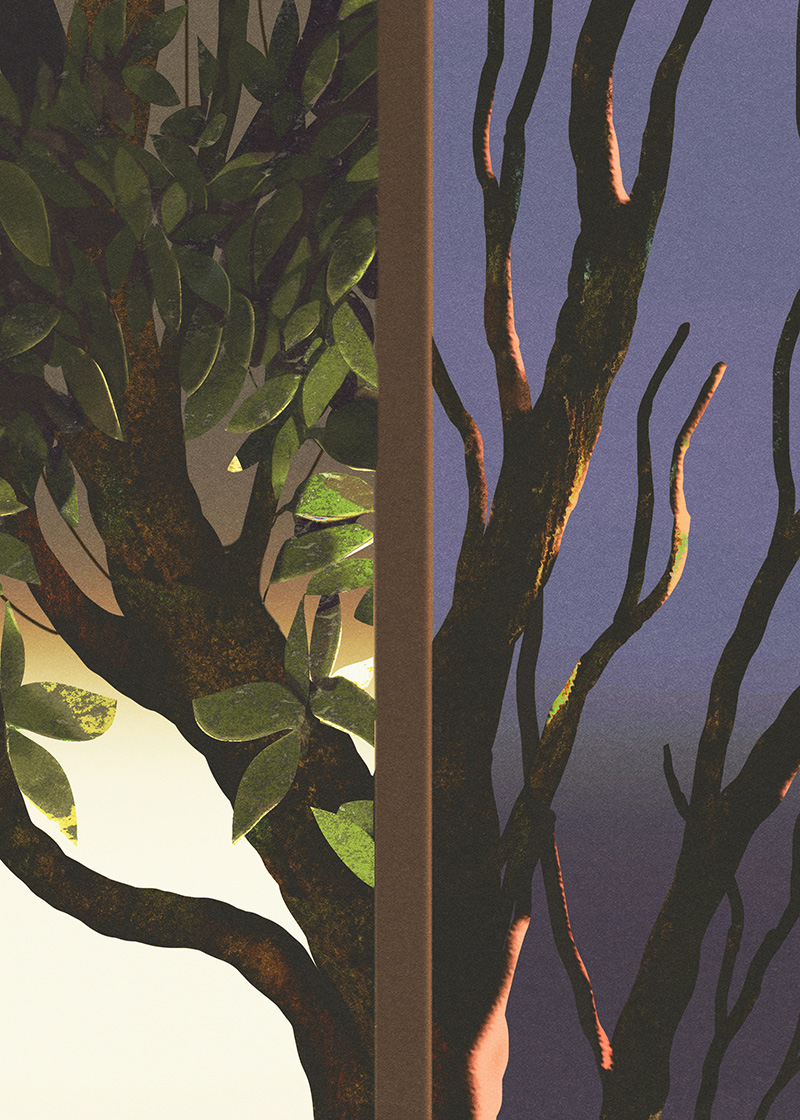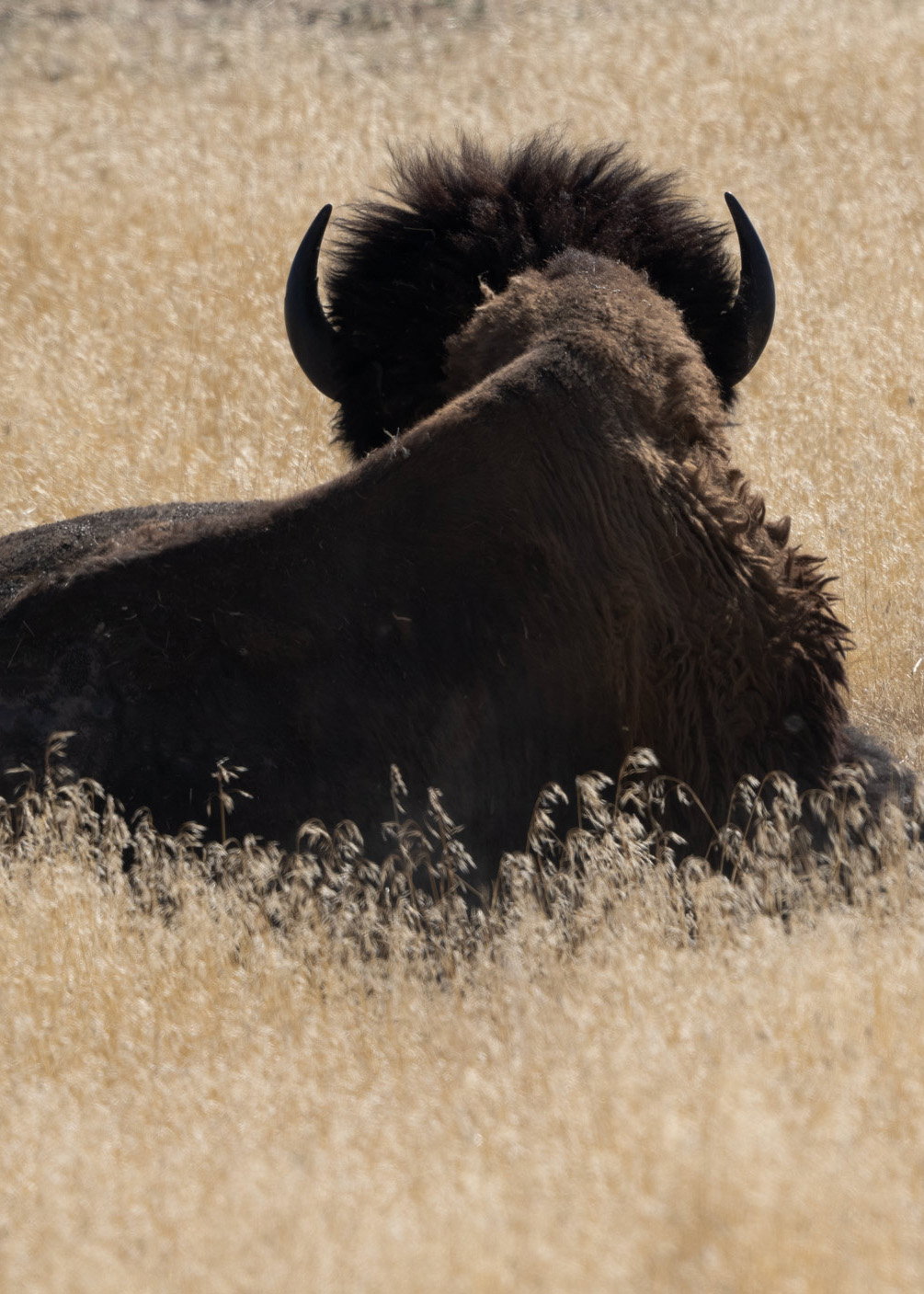
Jake Skeets is Black Streak Wood, born for Water’s Edge. He is Diné from Vanderwagen, New Mexico. His debut collection of poetry, Eyes Bottle Dark with a Mouthful of Flowers, was a winner of the National Poetry Series, the American Book Award, and the Whiting Award. He won the 2018 Discovery/Boston Review Poetry Contest and has been nominated for a Pushcart Prize. His honors include a 2020–2021 Mellon Projecting All Voices Fellowship and the 2023–2024 Grisham Writer in Residence at the University of Mississippi. His research explores Diné poetics and aesthetics, ecopoetics, Indigenous queer theories, and critical Indigenous feminisms. He currently teaches at the University of Oklahoma.
Observing the grief that has arisen during the coronavirus pandemic, poet Jake Skeets explores apocalypse, time, and futurity from a Diné perspective.
My family tells many stories. They are the best storytellers. They use language efficiently and precisely. They have a keen sense and understanding of time. It is through the reimagining of time within their storytelling that they conjure survivance. Of course, we are not allowed to gather today, as the world battles a virus. As a child, I remember the many times my family gathered over mutton, watermelon, and tortillas. We gathered near our hogan at the Other House. My aunts and their families live a short walk from my childhood home. We all refer to their collective homes as the “Other House.” Each home of the Other House holds memories that I remember during these long, tense days. The Other House holds time through our memories. The Other House as a construct and physical space is as sophisticated as any technology. The energy of our landscapes is enough to hold so much of ourselves. The reimagining and reconfiguring of time, I believe, starts with the land.
Today, I notice, among the newfound excitement of working from home, small moments of tense air. These small pockets of density last only moments before another joke cracks or a sarcastic remark bursts the room into laughter. My house is composed of three young adults in their late twenties. We are all relatively healthy, except for the existential dread of family histories that include diabetes, high blood pressure, certain types of cancers, alcoholism, and mental illness, which are not uncommon among most Native populations across the United States. These temporary moments, though small, are still large enough to notice in the room. I feel their heft balloon in the room before it pops and plastic ribbons fall gently around us. I saw an article headline recently that said this stillness is actually grief. If grief, what are we grieving?
Perhaps grief is related to time. Once upon a time, I considered my best childhood experience to be the many times my older cousin brother would drive us to Gas Man, a local convenience store, to buy junk food. I would stock up on Mr. Goodbar, Flamin’ Hot Cheetos, and nachos with extra cheese. It is still argued that our Gas Man store has the best nachos because of the cheese. The store sits on checkerboarded land, so it is actually not on the reservation. This means it can and does have a liquor license. Each Sunday, as we approached Gas Man, we would see men and women lined up out the door looking to enjoy a drink, or many. Reflecting now, perhaps that is not the best experience to recall, as some of my cousins have become those very men and women. Hell, even I have waited in one of those lines. Maybe the small air that heavies when I drive past the store is also filled with grief, and only with time is this grief possible.
Where Gas Man at?
Where Gas Man at?
Shí ga’ anishní
Far away,
Far away,
Shí ga’ anishní 1
Diné College (DC), where we all work, is considered the first tribally controlled college in the United States. It was founded in 1968 to address the needs of the Navajo Nation. Today its Board of Regents is selected by the Navajo Nation government. When the coronavirus pandemic first hit the United States, DC was very quick to respond. The college has restricted access to the campus. Like a majority of faculty and staff, we are at home. Our days are relatively routine. My partner and I make breakfast and then continue our day mixing work, chores, and breaks. My breaks are spent mostly playing solitaire, Scrabble Go with my older sister, or checking social media. Lately, my breaks also included writing this essay and other small poems. Several posts on Twitter and Facebook lament the impossibility of poetry. How can we write poetry at a time like this? How can we write poetry during the apocalypse? Why poetry? How poetry? This essay is not a reflection on why poetry is or is not necessary. Instead, this essay focuses on these so-called end times. I write through and about the concept of apocalypse, time, and futurity from a Diné perspective.
I ask again, if this stillness that envelops the room cyclically is grief, what are we grieving? The world faces a global pandemic, and that type of devastation reaching our reservation, where basic infrastructure and healthcare are already limited because of past and current conquest, would be catastrophic. It would be apocalyptic even. So each day passes with a reminder from the Navajo Nation president to remain at home and limit visiting our families. Each day more cases are confirmed and I am sure each one of us worries about a confirmed case within our family. The Navajo Nation now has the highest number of coronavirus cases per capita in the US, higher than even the hardest hit states of New York and New Jersey. High schools are now being turned into temporary care centers and command bases for the tribe and state National Guard. High school gymnasiums that once housed Navajo families watching a game of basketball, because rezball is everything on the reservation, are now housing Navajo people infected with this virus. That, for me, is enough for grief. However, there’s something else as well in all that grief, I think.
As with time, I find yearning is an element of grief because we yearn for and desire an absence of grief. As an undergrad, I would run several miles on Johnson Field, an outdoor track on the University of New Mexico’s main campus. During these runs, I would yearn for and desire several things. First, it was hard not to desire the mostly white men completing their workouts on the field. Second, I would imagine myself publishing a book and talking about a book. I would imagine titles of potential collections. I told myself, in true American Dream fashion, that I would become successful. My success, however, was tied to money, capitalism, and advancement of the individual (and not necessarily the self). Today it seems foolish to imagine myself not connected to my community. My community is what molded me, and my success is only possible because of this place. So I often imagine my younger self running on Johnson Field, yearning for something that is causing the current troubles of the world today.
Where Johnson Field at?
Where Johnson Field at?
Shí ga’ anishní
Far away,
Far away,
Shí ga’ anishní
If grief is tied to yearning and we are indeed grieving and thus yearning, for what or whom do we yearn? The world before this pandemic was already lethal: see the list of conditions above and add to it the long list of things impacting Native and Indigenous communities across the country. I grew up with several cousins I consider brothers. More than half of them we lost either to death or incarceration. Every month, there are numerous headlines announcing the deaths that occur in border towns around the reservation. So if we yearn for the time before this virus, are we also yearning for those ills as well? Or do we yearn for the post-pandemic, which will include either further disaster capitalism or the so-called end times, both of which would be catastrophic for families in the United States? The strangeness for me exists in the fact that even yearning has been conquered. Our yearning has been colonized to such an extent that we can only yearn for the very things that result in colonization. Perhaps that is an apocalypse of the human condition as much as the human experience on earth.
Apocalypse is a funny thing. I do not mean funny as in humorous but funny as in there is not much to feel about it. For me, apocalypse has always been represented in two ways: as an end to human life or a replacement of human life. In the feature film Resident Evil: Extinction, we follow the story of Alice navigating post-apocalyptic Las Vegas where human life has ceased to exist due to zombie outbreaks. On the other hand, X-Men: Apocalypse is a prophetic tale about the character Apocalypse and his intention to destroy the current world and to replace it with a new super civilization. (Cut to my partner mocking Apocalypse’s line, “Everything they built will fall.”) Both of these representations seem overly dramatized. Apocalypse is actually a project of colonialism. The linearity of beginning and ending is the very construct of the American Dream (for which we yearn and grieve). Our futures are set in a binary of success or apocalypse, depending on how tight we tie our bootstraps. The essay “Rethinking the Apocalypse: An Indigenous Anti-Futurist Manifesto” posted by Indigenous Action (indigenousaction.org) details the way apocalypse is a linear project that relies on a colonial past.2 It asks the question, “Why can we imagine the ending of the world, yet not the ending of colonialism?” Colonialism is somehow both immune to an end and reiterates that human lives can and do end. The essay rejects a colonial future and relies on the deep time of Indigenous people. After all, Indigenous people have gone through many beginnings and endings, but never linearly and never without teaching.
As with time, I find yearning is an element of grief because we yearn for and desire an absence of grief.
There is a joke my father told me as a child. Language and culture loss continue to worry many Diné elders on our reservation; there are several revitalization efforts ongoing to address these losses. As a result, high school students can take Navajo language classes to fulfill foreign language requirements, and most universities and colleges now recognize Navajo as a foreign language, despite its millennia-long existence in the Southwest and its Athabascan relatives to the north and south. The joke my father told captures the politics of language and culture loss and revitalization within a singular punch line. The joke takes place in Chinle, Arizona, a small town located near the heart of the Navajo Nation. Its place name in Diné is Chʼínílį́. The joke is as follows: Two men are arguing over a meal about the correct pronunciation of Chinle. One says they are in Chinle, using the English pronunciation. The other says they are in Chʼínílį́, using the Diné pronunciation. To settle the dispute, one stops a restaurant worker and asks her, “Are we in Chinle or Chʼínílį́?” The worker replies, “Sir, you are in Burger King.” The joke acknowledges the existence of a Burger King near the heart of the Navajo Nation.
The Burger King is still a popular destination. Before the outbreak, I made the twenty-minute journey myself to enjoy a burger and fries. Outside, numerous unsheltered Diné relatives asked for money or rides. Today the Burger King still has the unsheltered Diné but no patrons dining inside. Instead a drive-thru line extends out into the main road. I repeat: apocalypse is a funny thing.
Where Burger King at?
Where Burger King at?
Shí ga’ anishní
Far away,
Far away,
Shí ga’ anishní
Ever since I was a child, I have heard tales of apocalypse and rebirth. In the Diné creation story, worlds are destroyed in apocalyptic ways, most famously by a flood. Each time, the Diné are able to escape through the sky to find a new world. Each time, the Diné take teachings and items from the previous world into the new one, thereby building our current reality from the ground up. Today, in ceremony, we bless ourselves beginning with our feet moving upward toward the sky. Diné weavers start a rug from the bottom and work their way up. So apocalypses have occurred within our history. Each time, we were reborn from the ground up. I have attended many presentations by Diné medicine people, and they each talk about another apocalyptic event, never with grief but with hope. Right now, it seems hope is hard to feel amid all this grief. Perhaps the social media questions and posts should not be about the impossibility of poetry but about the impossibility of hope.
Hope, however, connotes a type of linear time wherein the subject that hopes is looking forward toward a future without the current challenge. This kind of hope I fear is linked to the onslaught of capitalism and the genocidal ideation of the American Dream. So maybe an answer lies within the reimagining of hope through the reimagining of time.
The reimagining and reconfiguring of time, I believe, starts with the land.
Diné time has never been linear. As mentioned above, time is literally built vertically. Time is never on a horizontal axis, never point A to B. Time is hard to imagine through a Diné lens. I’m sure most Diné medicine people and fluent speakers of Diné know the concept of time. For me, a non-fluent speaker, I am on the periphery, ever caught between vocabulary drills and spelling tests and never between the conceptualization and actualization of the Diné language. I do not dream in Diné, and there lies the challenge. However, even from the periphery, I can see time as a nonlinear construct. In English storytelling, one famous phrase we learn early on is “once upon a time.” This phrasing marks time within a particular story as existing in a past and marked on a timeline. Hence the operative word “once,” as in “in this moment this happened.” To make a dangerous reductive comparison, Diné has a similar (but not quite the same) marker of time when storytelling, and that is ałkʼidą́ą́.3 Dą́ą́ is the reference to time. However, the words before dą́ą́ don’t mean “once upon.” After several days of wrestling with translation, I conclude now that there is no neat translation of ałk’i-, but through its broken components, we can piece together an idea of how time is constructed in Diné. K’i is related to planting, perhaps referencing the way plants grow from the ground up or a planting of a thing that took place in time, and this story is the harvest. Like “once,” the Ł takes center stage in this phrasing. I thought long and hard about the Ł and its translations. Many words use Ł, including dił (“blood”), łeezh (“sand”), łį́į́’ (“horse”), and dootłizh (“turquoise”).4
After conversations with my partner, we concluded that the Ł connotes a deep space that has the capacity to possess an entity within it, like time. Dił translates as “blood” and we see how the Ł here references an internal function of the body. Łeezh translates as “sand.” After each apocalypse, our deities carried with them sands from the previous worlds, sands from deep beneath us. This deepness of the world is also represented in the word dootłizh, which translates as “turquoise,” and from that translation can also mean the color blue or green. However, the Ł in this word connotes the deepness of turquoise itself. Whenever I hear the word, I first think of the deep black markings within the blue. Łį́į́ʼ is an onomatopoeia that translates as “horse.” The sound is a matching of the sounds of horses. It uses the nasal and guttural spaces of the head. A medicine person told me once that the breath is the connection between the physical external and the sacred internal, so sound, language, and breathing are considered sacred acts. The nexus being the nasal and guttural spaces of the head. Hair represents rain on a body and the neck represents clouds. This means the head makes up sky space and łį́į́’ is a direct engagement with that idea. The Ł in ałkʼidą́ą́ then becomes a reference to a story being conjured from a deep space and time.5 Time in actuality is built from the deepest spaces of the human and geological body and consciousness.
So perhaps time actually extends from within us and beneath us, from our pasts. And because we are in active movement, each moment of present time is actually our future. Our bodies are our future. Our landscapes are our future. So if we return to the manifesto of an anti-colonial future, we can also employ an anti-colonial hope. One that doesn’t rely on linearity but that is deeply intimate, from the deep space and time of the self. One that is birthed from the deepest parts of our bodies and times. For me, the best way to achieve this is through storytelling and language. I think maybe this is an answer to the question about the impossibility of poetry: the possibility of storytelling. Storytelling has the ability to conjure the deepest parts of ourselves and reimagine time and thus reimagine hope. Storytelling allows us to embrace what is far away, remember what was forgotten, and hope for a future existing now. It starts with Ałkʼidą́ą́, “Once upon a time…”
Where’s the Other House at?
Where’s the Other House at?
Shí ga’ anishní
Far away, Far away,
Shí ga’ anishní
Far away,
Far away,
Shí ga’ anishní
- The lyrics to “Far Away” that are mixed within the text are borrowed from Shinálí Luci Tapahonso’s poem and song “Far Away,” from her collection A Radiant Curve.
- The idea of an anti-colonial future comes from the manifesto “Rethinking the Apocalypse: An Indigenous Anti-Futurist Manifesto,” posted by Indigenous Action. The full text can be found at
http://www.indigenousaction.org/rethinking-the-apocalypse-an-indigenous-anti-futurist-manifesto/. - The work on the concept of ałkʼidą́ą́ is not new. Many scholars are working to examine this phrase. Friend and fellow Diné scholar Manny Loley is working on ałkʼidą́ą́ and its connection to land, authority, and Diné literature. I would like to acknowledge and reference his essay “From the Mountaintop: Ruminations on Diné Time, Landscape, and Storytelling.”
- As always, so much appreciation to my partner, Quanah Yazzie. He continues to help me with translations and helps me think through these concepts.
- These musings should not be considered ultimate. Variations exist for a reason. Language has many possibilities. This essay is just one rendering in the infinite continuum of renderings.
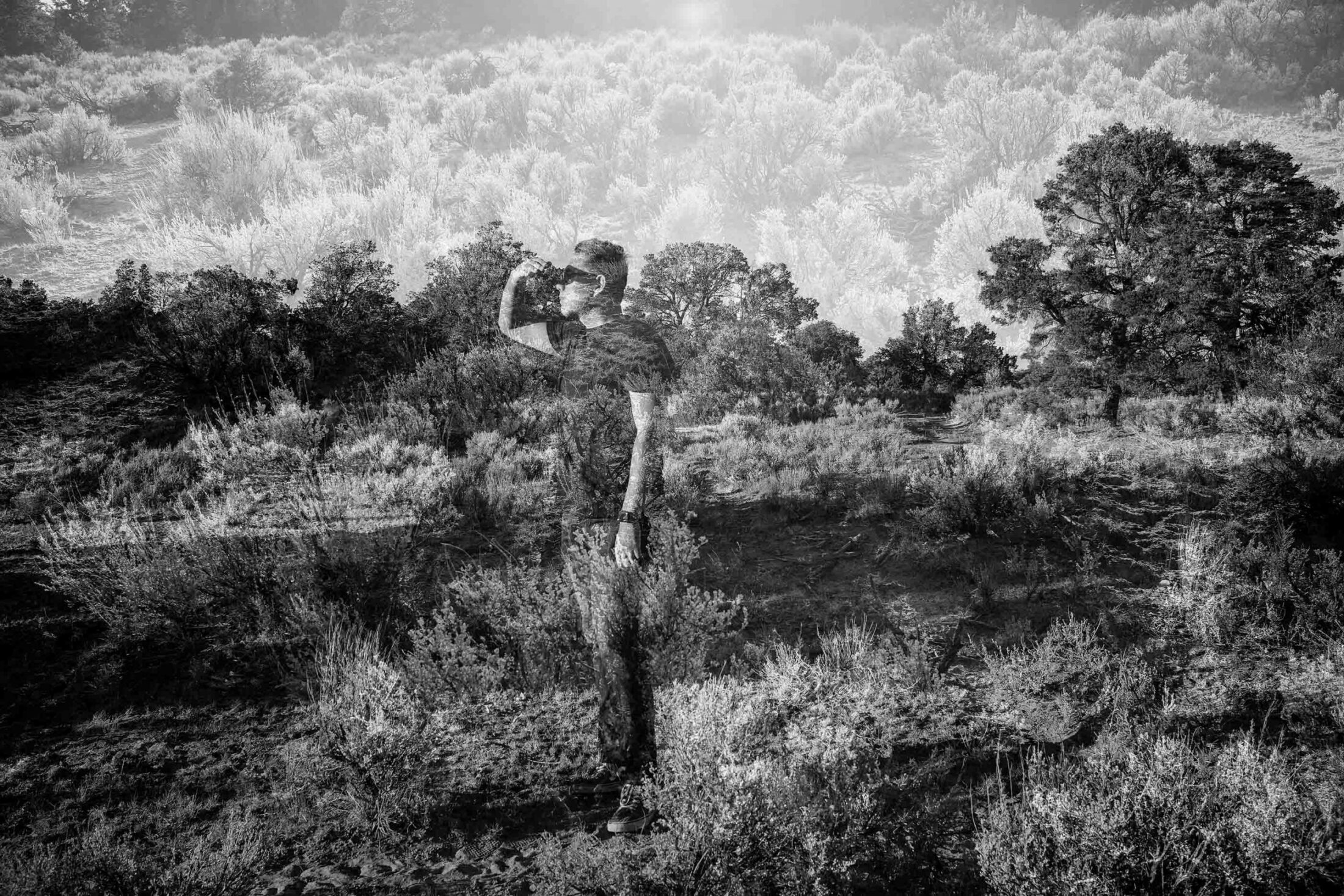
The Memory Field
Recalling visceral moments in his life, poet Jake Skeets explores how time and land hold “fields” of memory that can unfold through language and storytelling.
